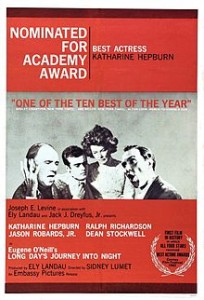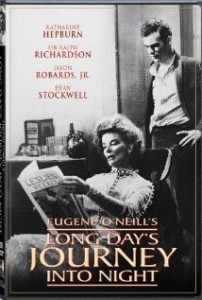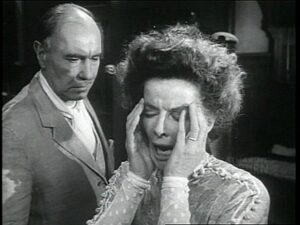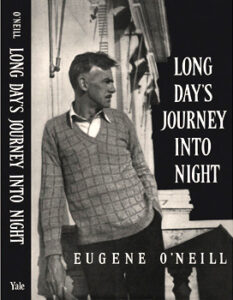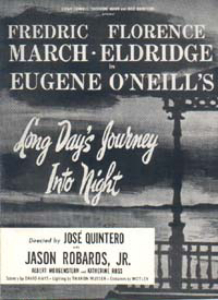Long Day’s Journey into Night **** (1962, Katharine Hepburn, Ralph Richardson, Dean Stockwell, Jason Robards Jnr) – Classic Movie Review 1,219
A marvellous cast brings Eugene O’Neill’s classic play about a dysfunctional family in 1912 Connecticut to vibrant life. Katharine Hepburn, Ralph Richardson, Dean Stockwell and Jason Robards Jr are magnificent, making the drama explosive on screen, and Sidney Lumet directs supremely skilfully.
Director Sidney Lumet is just the man to bring the classic Eugene O’Neill play Long Day’s Journey into Night about the trials and tribulations of a dysfunctional Connecticut family to the screen. And here in the 1962 American drama film Long Day’s Journey into Night, Lumet makes his usual meticulous job of it.
It is set on a fateful, heart-rending day in August 1912 at the seaside home of the Tyrone family. All are addicted – the three men are alcoholics and the mother is hooked on morphine.
The play makes for a spectacularly long night on the stage, which can run nearly five hours with intervals, as it is in four acts with three intervals, and it seems a long journey on screen here too at just under three hours. Notably O’Neill’s entire play forms the relentlessly downbeat and depressing screenplay, bringing out his themes of addiction and dysfunction, as the self-obsessed family engage in a bitter, ever-escalating conflict intercut with quiet moments of sympathetic reaching out and affection.
It takes great acting to bring out the best in the play, though it inspires it too. This finds four remarkable, ideally cast actors on their absolute best form. Audiences can safely sit back and relish Katharine Hepburn as the drug-taking, morphine-addicted matriarch Mary Tyrone, Ralph Richardson as her starchy, stuffy husband James Tyrone Sr, Dean Stockwell as her sick and sensitive son Edmund Tyrone, and Jason Robards Jnr as his drunken brotherJamie Tyrone.
All four are astonishing. Hepburn was nominated for the Academy Award and Golden Globe for Best Actress. All four won the Best Actor/ Actress award at the 1962 Cannes Film Festival, where it premiered it May 1962 before opening in New York City on October 10, 1962. (The film was also nominated for the Palme d’Or.) There’s only one other player, Jeanne Barr as Cathleen.
Lumet could be a brilliant realist director as he showed with Serpico or Dog Day Afternoon, but in dealing with stage material he doesn’t attempt to make it cinematic or ‘real’, relying on the theatricality of the play and the performances to score its full impact on screen. He had achieved this already with his 1957 film Twelve Angry Men.
The score is by André Previn and the cinematography by Boris Kaufman.
It was shot at Chelsea Studios in New York City with the exteriors at a house on City Island in the Bronx. Shooting took place over 37 days, two days over schedule. After three weeks of rehearsals, the film was unusually shot in sequence, and even more unusually, a direct filming of the stage play, without any major cuts or changes. The budget was either $435,000 or $490,000.
It is produced by Ely Landau and executive producer Joseph E Levine, who bought the rights for distribution but revealed that he lost money on it. As he said: ‘You cannot stay in business by making O’Neill pictures’. However, Lumet said ‘there actually were some profits’. This is interesting because the cast and the director had formed a cooperative, agreeing to work for a lower fee in exchange for a percentage of the profits – if there were any. Landau had produced a version of The Iceman Cometh for TV, which Eugene O’Neill’s widow liked so she agreed to offer him the Long Day’s Journey screen rights.
Full version at 176 minutes but the cut version runs at 136 minutes.
It is distributed by Embassy Pictures.
It was digitally remastered for home video for release on its 30th birthday in 1992.
Marlon Brando was offered the role of Jamie Tyrone but turned it down. That was lucky for Jason Robards, who thus became the only actor from the 1957 Broadway stage version to star in the film. He had won the Tony Award for Best Featured Actor in a Play as Jamie Tyrone, and reprised the role in O’Neill’s sequel A Moon for the Misbegotten. Afterwards he played James Tyrone in several productions of Long Day’s Journey.
Ely Landau (January 20, 1920 – November 4, 1993) had a passion for adapting theatrical productions to film, and is also remembered for producing films of plays in the American Film Theatre series. They include A Delicate Balance (1973), The Homecoming (1973), Butley (1974), The Iceman Cometh (1974), Lost in the Stars (1974), Luther (1974), Rhinoceros (1974), Galileo (1975), In Celebration (1975), The Maids (1975), and The Man in the Glass Booth (1975).
Landau worked with Hepburn on The Madwoman of Chaillot (1969) and A Delicate Balance (1973).
Long Day’s Journey into Night was first performed in Swedish on 2 February 1956 by the Royal Dramatic Theatre in Stockholm. The Swedes loved gloomy old O’Neill.
It had its American premiere at Boston’s Wilbur Theatre and debuted shortly after on The Broadway at the Helen Hayes Theatre on 7 November 1956. The production was directed by José Quintero, starring Fredric March (James Tyrone) and March’s wife Florence Eldridge (Mary Tyrone), along with Jason Robards Jr (Jamie Tyrone), Bradford Dillman (Edmund), and Katherine Ross (Cathleen). It won the Tony Award for Best Play and Best Actor in a Play (Fredric March).
Its first UK production opened in Edinburgh in 1958 and moved to London’s Globe Theatre. It wasagain directed by Quintero, and the cast were Anthony Quayle (James), Gwen Ffrangcon-Davies (Mary), Ian Bannen (Jamie), Alan Bates (Edmund), and Etain O’Dell (Cathleen).
© Derek Winnert 2014 Classic Movie Review 1,219
Link to Derek Winnert’s home page for more film reviews: http://derekwinnert.com/

